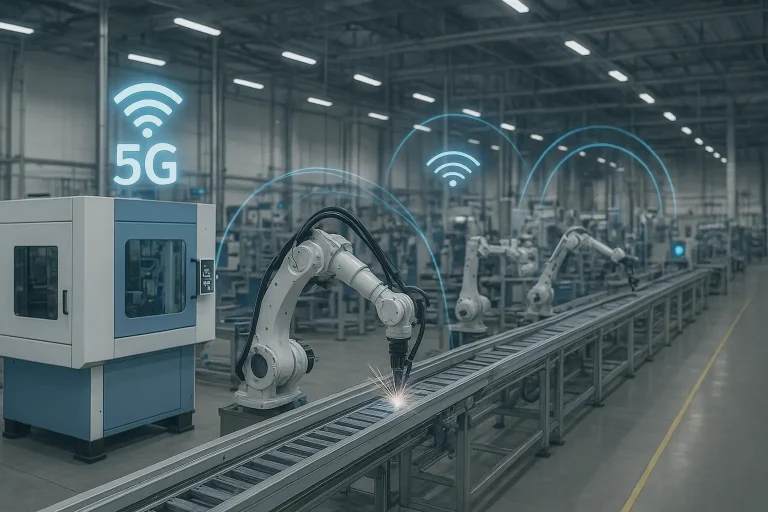The Future of Industrial Networking: Unleashing the Power of 5G and TSN
The future of industrial networking is rapidly transforming as industries worldwide embrace cutting-edge technologies like 5G and Time-Sensitive Networking (TSN). These advancements promise to revolutionize the way industrial systems communicate, paving the way for unprecedented levels of automation, efficiency, and reliability in sectors such as manufacturing, energy, transportation, and more. As we look ahead, understanding how 5G and TSN integrate and complement each other offers a glimpse into the intelligent factories and smart infrastructures of tomorrow.
Understanding the Current Landscape of Industrial Networking
Industrial networking has always been the backbone of manufacturing plants, power grids, and transportation systems, facilitating robust data communication between machines, sensors, controllers, and human-machine interfaces. Traditionally, wired Ethernet connections with protocols like PROFINET and Modbus dominated the scene, ensuring deterministic communication critical for control and automation.
However, with the increasing complexity of Industrial Internet of Things (IIoT) deployments, including the explosion of connected devices, sensors, and autonomous systems, enterprises face mounting challenges. These involve latency, bandwidth constraints, system interoperability, and cybersecurity vulnerabilities. Addressing these challenges points directly toward new networking paradigms — notably 5G and TSN.
Why 5G Is a Game-Changer for Industrial Connectivity
At its core, 5G offers ultra-high bandwidth, low latency, massive device connectivity, and improved security features that perfectly align with the demanding needs of industrial environments. Unlike previous cellular standards, 5G networks enable data transfer speeds exceeding 10 Gbps with latency as low as 1 millisecond, essential for time-critical applications like real-time monitoring, predictive maintenance, and autonomous robotics.
Moreover, 5G’s ability to support large-scale device density without network degradation means it can accommodate tens of thousands of Industrial IoT endpoints within localized environments. This expansive capacity and flexibility free industries from the limitations of wired infrastructure, enabling more agile factory floor layouts, rapid deployment, and cost efficiencies.
The Role of TSN in Delivering Predictability and Precision
While 5G provides wireless speed and scalability, it alone cannot guarantee the deterministic behavior necessary for mission-critical industrial processes. This is where Time-Sensitive Networking (TSN) comes into play. TSN is a set of IEEE standards designed to enhance Ethernet by introducing features that ensure minimal latency, seamless synchronization, and guaranteed delivery times for data packets.
With TSN, industrial applications gain the ability to prioritize traffic and handle multiple streams of data simultaneously without jitters or unpredictable delays. This is especially vital for operations like motion control and safety systems, where even microseconds matter.
Integrating 5G and TSN: A Synergistic Approach
The future of industrial networking lies in the convergence of 5G and TSN technologies, combining wireless flexibility with deterministic performance. This integration enables the seamless extension of TSN’s precise timing and traffic shaping capabilities over 5G’s radio interface.
For example, in a smart factory, robotic arms, autonomous guided vehicles (AGVs), and sensors can communicate wirelessly with control systems while maintaining strict timing requirements. The use of 5G’s network slicing allows the creation of dedicated virtual networks tailored for different industrial applications, ensuring isolation and guaranteed resource allocation.
Additionally, aligning 5G’s cellular frameworks with TSN standards fosters interoperability across heterogeneous networks, bridging wired and wireless segments in hybrid deployments. This approach not only increases operational resiliency but also supports scalability as organizations expand their digital ecosystems.
Key Benefits Driving the Future of Industrial Networking
The fusion of 5G and TSN heralds a new era of smart manufacturing and industrial automation, delivering numerous benefits:
- Enhanced Real-Time Control: Ultra-low latency and deterministic communication empower precise control over machinery and processes.
- Increased Flexibility: Wireless connectivity allows dynamic reconfiguration of production lines with minimal downtime.
- Greater Scalability: Supports massive connectivity for IIoT devices without congesting the network.
- Improved Reliability: Robust fault tolerance and redundancy mechanisms reduce system failures.
- Superior Security: Advanced encryption and network slicing protect against cyber threats.
- Cost Efficiency: Reduction in cabling and infrastructure expenditures lowers overall operational costs.
Challenges and Considerations for Adoption
Despite its promising outlook, widespread adoption of 5G and TSN in industrial environments is not without hurdles. Integrating these technologies into legacy systems requires significant investments and training. Compatibility issues may arise as diverse industrial equipment and protocols coexist.
Moreover, operators must carefully plan network architecture to balance performance with security risks. Regulatory compliance, spectrum availability, and standardization efforts continue to evolve, necessitating active collaboration between industry stakeholders, vendors, and standards organizations.
Looking Ahead: The Industrial Network of Tomorrow
As 5G and TSN technologies mature, industries are set to unlock new capabilities for autonomous operations, AI-driven analytics, and edge computing integration. Future industrial networks will be intelligent, adaptive, and resilient, capable of supporting complex workflows that drive productivity and innovation.
By embracing this technological shift, companies can future-proof their infrastructure, meet the demands of digital transformation, and maintain a competitive edge in an increasingly connected world.
In summary, the future of industrial networking is shaped decisively by the symbiotic relationship between 5G and TSN. Together, they enable a new generation of industrial ecosystems characterized by unprecedented connectivity, precision, and automation — laying the foundation for the factories and infrastructures of the future.




